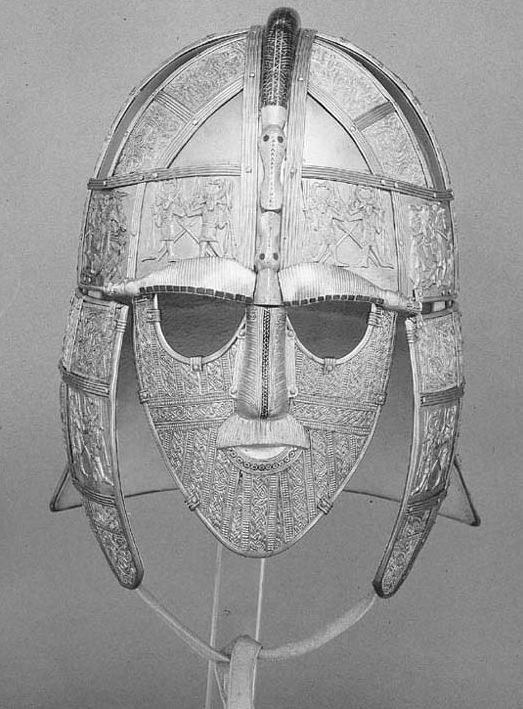- Sutton Hoo
- Site (in England's Somerset region) of one of the most important archeological discoveries for the history of the Anglo-Saxon kingdoms. In 1939 a burial mound was discovered at Sutton Hoo by Basil Brown that revolutionized modern understanding of pre-Christian Anglo-Saxon civilization. The discovery of a burial ship and its possessions from the first quarter or first half of the seventh century transformed the prevalent perception of early East Anglian courts, and Anglo-Saxon royal courts in general, as impoverished and backward centers with few contacts outside England; it revealed a dynamic court life with wide-ranging contacts with the European continent.The burial site, noted for its extraordinary richness, is without human remains and may have been a site intended as a memorial rather than a place of interment. Whatever the case, the question of whose burial mound it was remains unanswered. Its close proximity to Rendlesham, the residence of the kings of East Anglia, and its contents have led to the theory that it was a royal burial site. Among those considered to have been buried in the 90-foot open rowing boat at Sutton Hoo are the seventh-century East Anglian kings Raedwald, Earpwald, and Sigeberht.The mound is remarkable for the number and variety of domestic and imported goods found inside. Among its numerous and luxurious possessions are the traditional burial goods of pre-Christian warriors, including spearheads, a wooden shield covered in leather, two large drinking horns, and a helmet. A sword decorated with gold and garnets is noteworthy for the skilled craftsmanship used in its creation. There is also an extensive cache of jewelry of great quality. Some of the jewelry is also decorated with gold and garnets, thus linking it with workshops in Kent and on the Continent. A gold buckle with interlacing snakes and small animals is both exquisite in design and typical of contemporary Germanic art. The mound also contains a huge whetstone, wooden buckets with silver mounts, a five-stringed musical instrument, fragments of chain mail and textiles of great quality, and an iron battle standard with bulls' heads. Products of foreign provenance in the find include a purse with thirty-seven gold coins from the Continent, a Byzantine salver with four stamps of the emperor Anastasius I (441-518), and a bronze bowl from the eastern Mediterranean.
 A gold helmet found at the Sutton Hoo burial site (Art Archive/British Museum/Eileen Tweedy)Although the original find was spectacular, it was not the end of the excavations at Sutton Hoo. Subsequent work has uncovered another twenty burial mounds and forty-four burial sites without mounds. The burial sites without mounds reveal that both inhumation and cremation were practiced, and they also contain possible evidence for the practice of human sacrifice. Whatever else is discovered at Sutton Hoo, the original find has contributed greatly to our understanding of this period and demonstrated the extensive contacts that England had with both the Frankish and Byzantine worlds, although more with the former than latter. Sutton Hoo also revealed the wealth and quality craftsmanship of this period of early medieval English history.See alsoBibliography♦ Bruce-Mitford, Rupert L. S. The Sutton Hoo Ship Burial. 3 vols. London: British Museum, 1975-1983.♦ Carver, Martin. The Age of Sutton Hoo. Woodbridge, UK: Boydell, 1992.♦ ---. Sutton Hoo: Burial Ground of Kings? Philadelphia: University of Pennsylvania Press, 1998.♦ Evans, Angela Care. The Sutton Hoo Ship Burial. London: British Museum, 1986.♦ Stenton, Frank M. Anglo-Saxon England. 3d ed. Oxford: Clarendon, 1971.
A gold helmet found at the Sutton Hoo burial site (Art Archive/British Museum/Eileen Tweedy)Although the original find was spectacular, it was not the end of the excavations at Sutton Hoo. Subsequent work has uncovered another twenty burial mounds and forty-four burial sites without mounds. The burial sites without mounds reveal that both inhumation and cremation were practiced, and they also contain possible evidence for the practice of human sacrifice. Whatever else is discovered at Sutton Hoo, the original find has contributed greatly to our understanding of this period and demonstrated the extensive contacts that England had with both the Frankish and Byzantine worlds, although more with the former than latter. Sutton Hoo also revealed the wealth and quality craftsmanship of this period of early medieval English history.See alsoBibliography♦ Bruce-Mitford, Rupert L. S. The Sutton Hoo Ship Burial. 3 vols. London: British Museum, 1975-1983.♦ Carver, Martin. The Age of Sutton Hoo. Woodbridge, UK: Boydell, 1992.♦ ---. Sutton Hoo: Burial Ground of Kings? Philadelphia: University of Pennsylvania Press, 1998.♦ Evans, Angela Care. The Sutton Hoo Ship Burial. London: British Museum, 1986.♦ Stenton, Frank M. Anglo-Saxon England. 3d ed. Oxford: Clarendon, 1971.
Encyclopedia of Barbarian Europe. 2014.
